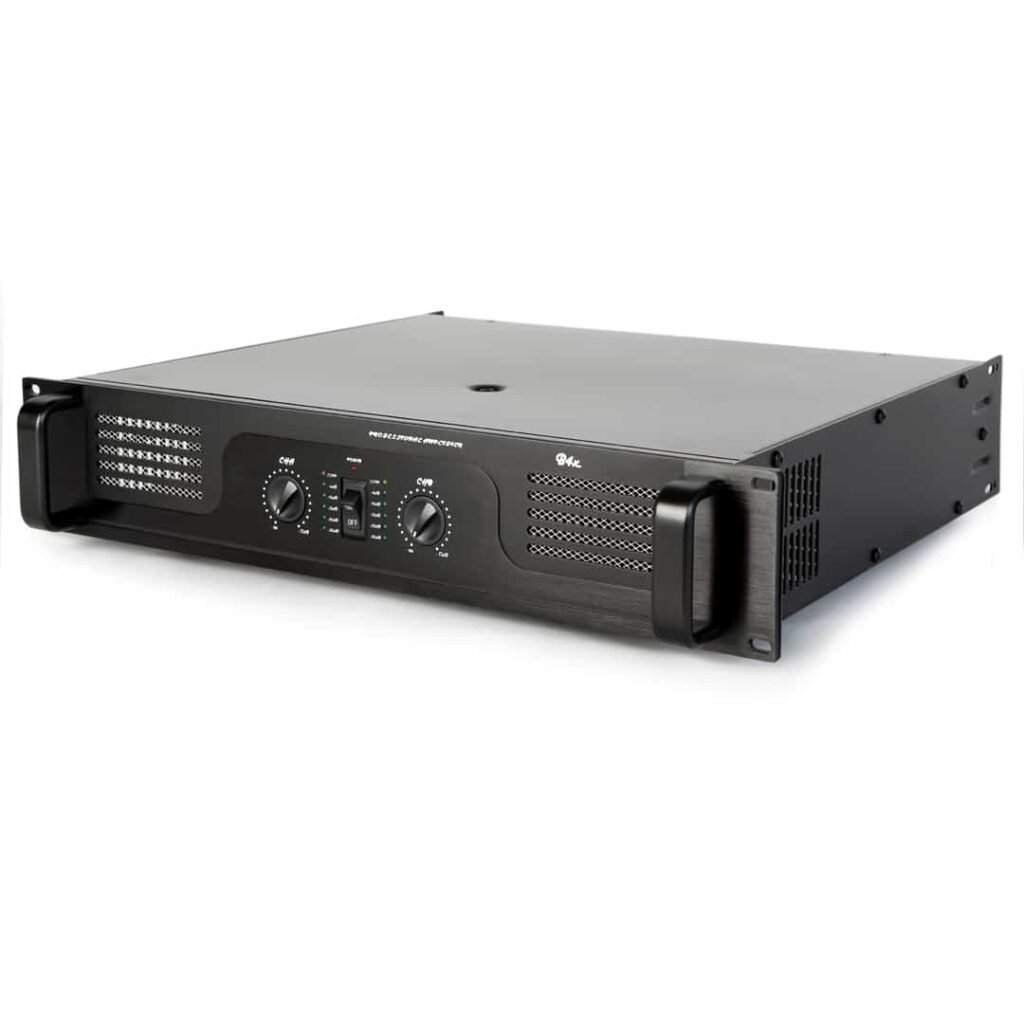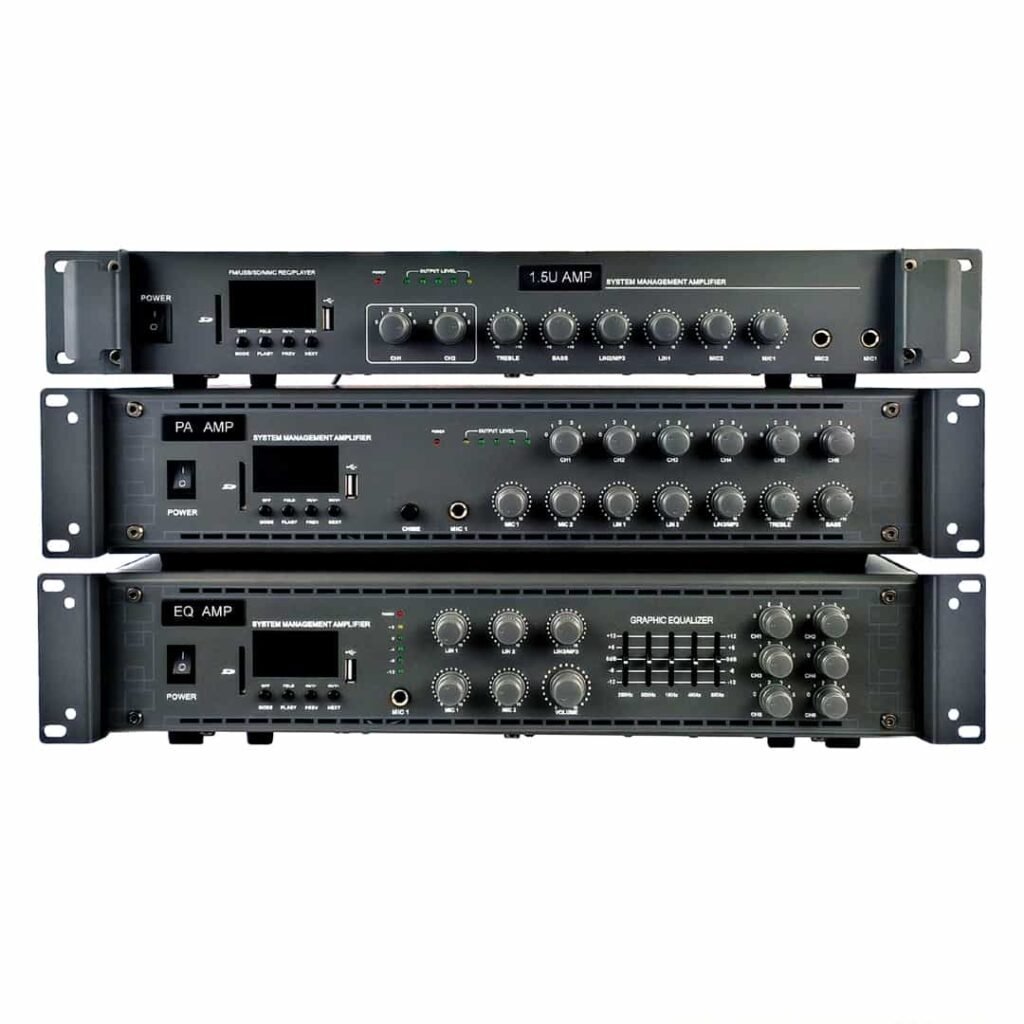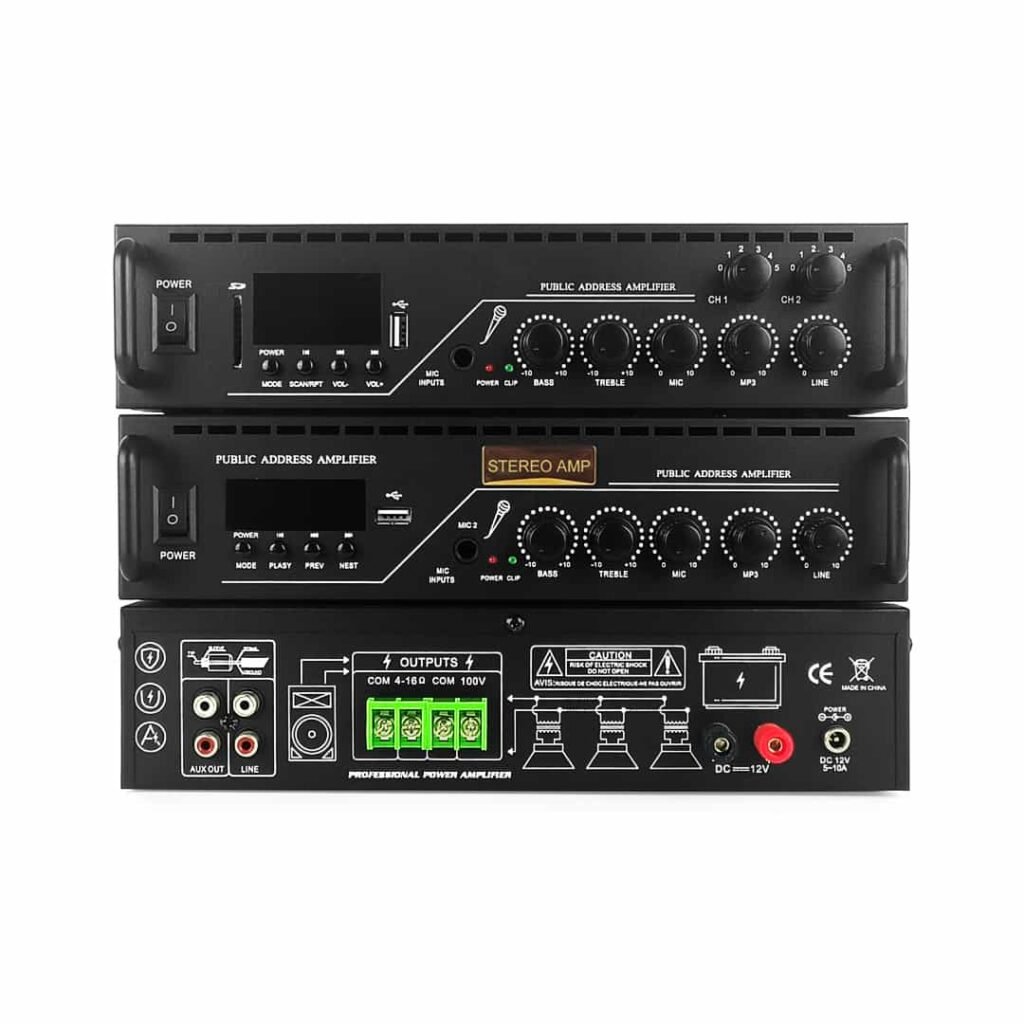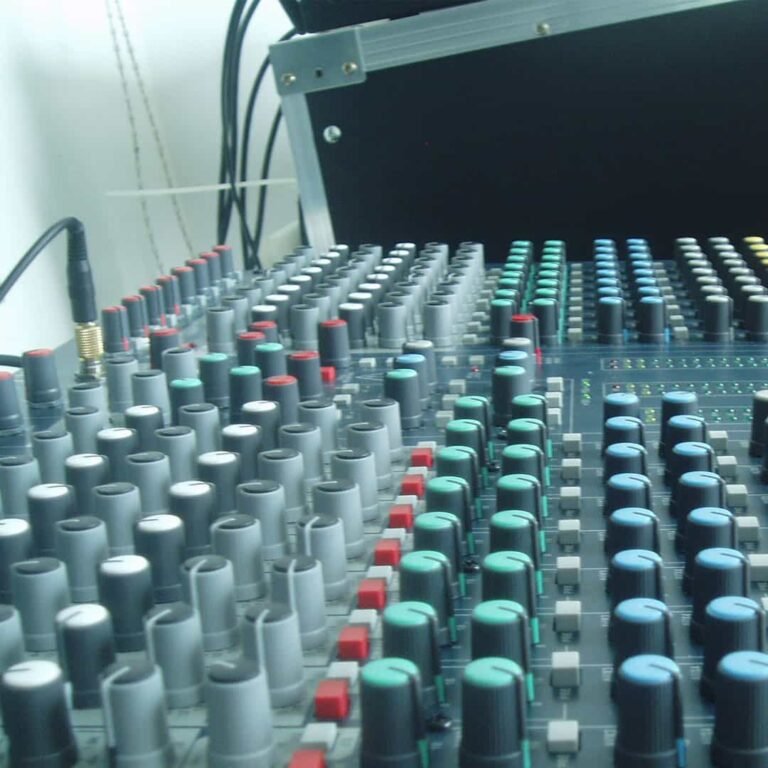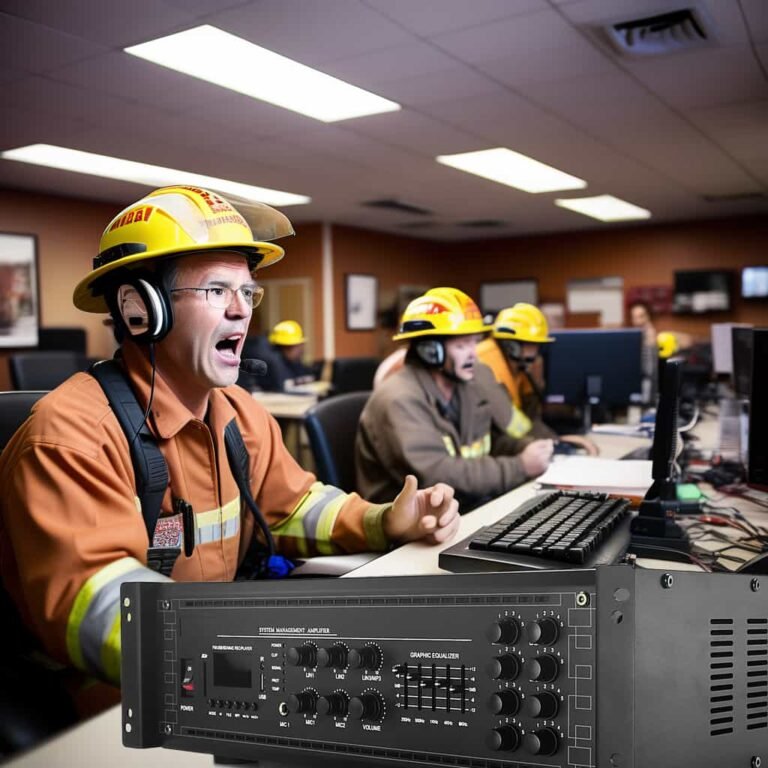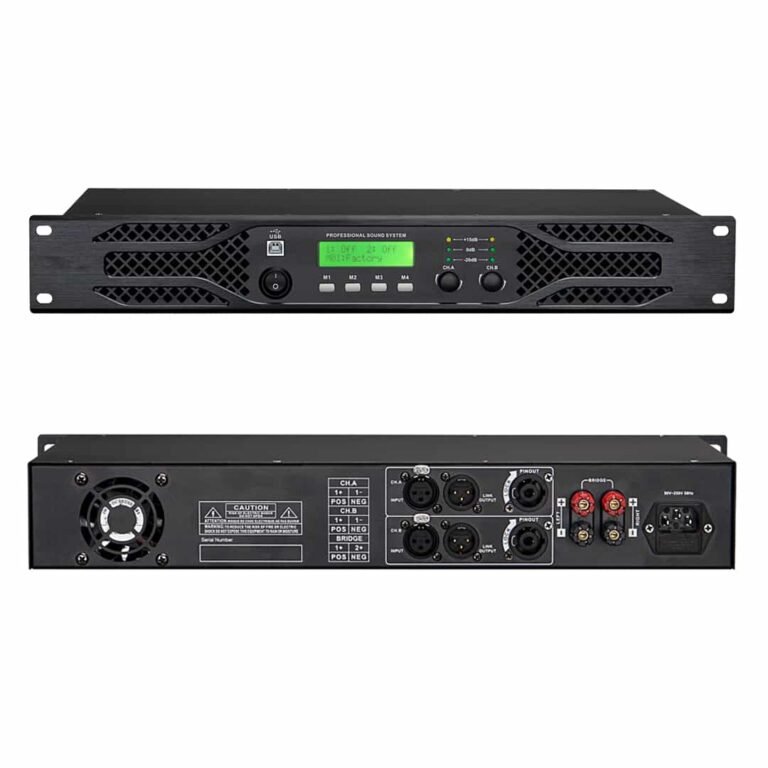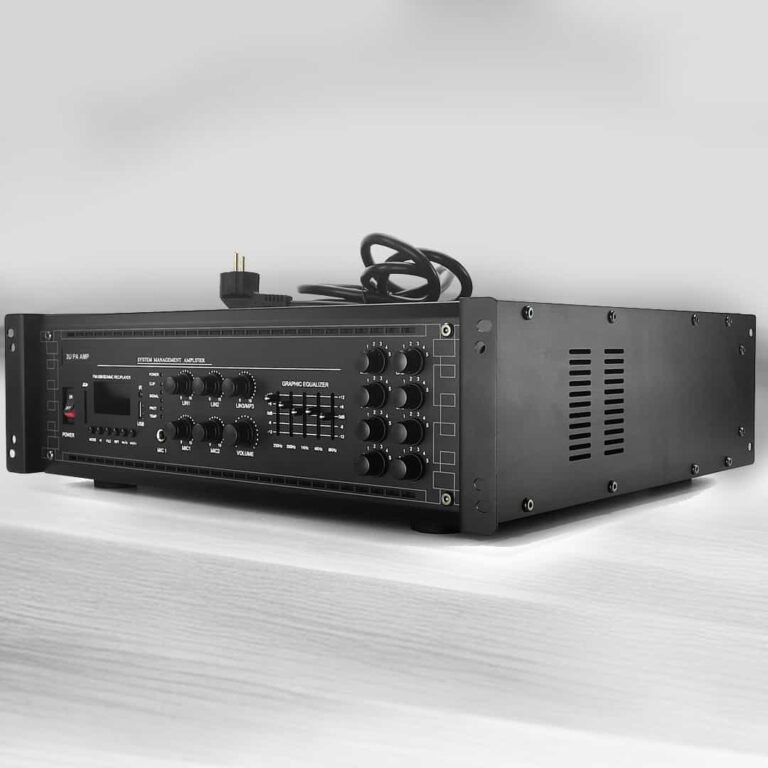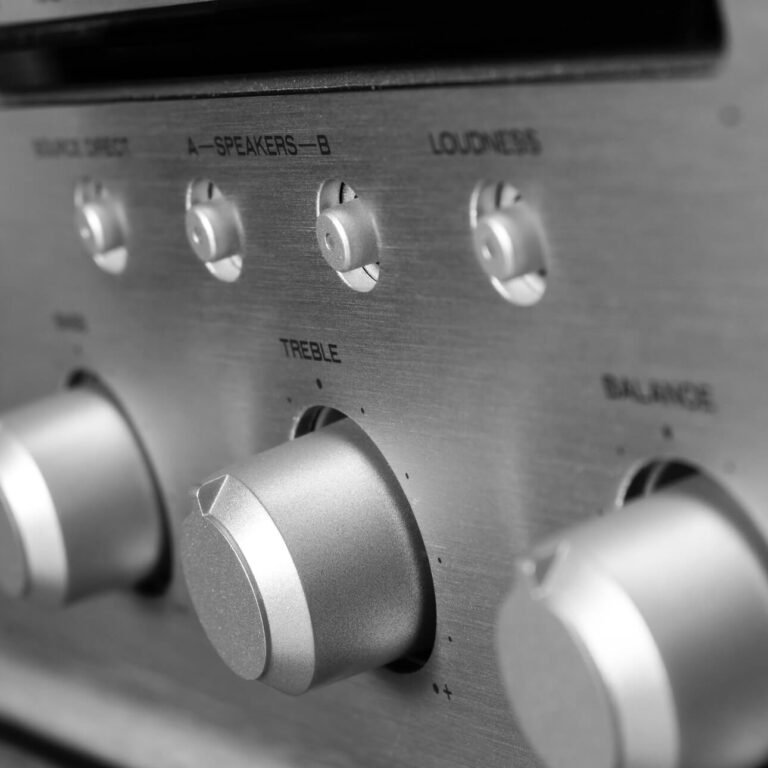Introduction to Public Address Power Amplifiers
PA amplifiers (Public address power amplifiers) are an essential part of sound reinforcement systems and are commonly used in public spaces, venues, and commercial environments. These PA power amplifiers play a vital role in providing clear and powerful audio to a large audience. It is necessary to thoroughly understand these PA amplifiers, their features, specifications, and factors to consider before making a bulk purchase decision. The purpose of this article is to take a detailed look at public address amplifiers, providing valuable insights into their key features, power output, efficiency, factors to consider when making a selection, the benefits of bulk purchasing, evaluation tips, and installation and maintenance considerations. By delving into these areas, you can conduct a comprehensive evaluation before purchasing them in bulk to meet your customization needs.
What is a Public Address Power Amplifier?
A public address amplifier is a piece of equipment specifically designed for use in a public address system, where its main role is to amplify audio signals and drive sound from loudspeakers. PA amplifiers play a vital role in public address systems because they amplify weak audio signals to a loud enough volume for broadcasting in large public areas or buildings.
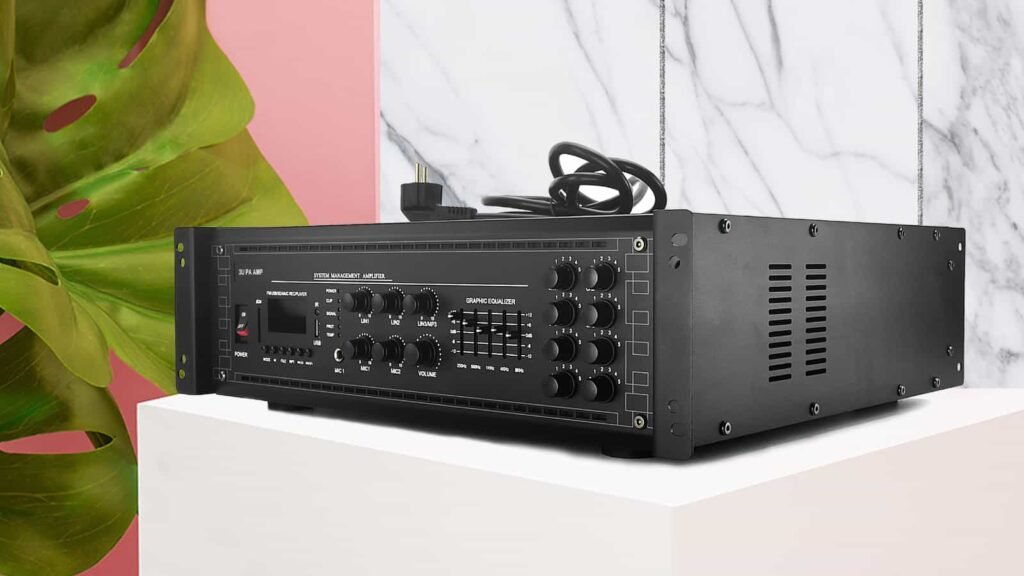
Key Features of Public Address Power Amplifiers
Wattage and Power Output
When it comes to PA amplifiers, power is one of the most central parameters. The power output in watts determines the distance the sound travels and the space-filling effect.
Power output is a key factor in determining the overall performance and sound quality of an amplifier. The higher the power, the louder and more powerful the sound produced by the amplifier. Wattage also plays an important role in an amplifier’s efficiency, as higher wattage means a greater ability to handle and distribute power without distortion.
Impedance
Impedance is the measure of opposition to the flow of electrical current, and it is measured in ohms. In a PA system, the amplifier sends an electrical signal to the loudspeakers, which then convert it into sound waves. The impedance of the amplifier and loudspeakers must be compatible for the proper transfer of power and to ensure that the system functions efficiently.
If the impedance of the amplifier is too high, it will not be able to supply enough power to the loudspeakers, resulting in a weak and distorted sound. On the other hand, if the impedance of the amplifier is too low, it will send too much power to the loudspeakers, potentially damaging them. Therefore, it is crucial to have a matching impedance between the amplifier and loudspeakers to achieve optimal performance and prevent any potential damage.
Load Compatibility
Load compatibility refers to the ability of the amplifier to handle the load presented by the speakers. The load is the amount of power that the loudspeakers require to produce the desired sound level. If the amplifier is not powerful enough to handle the load, it will not be able to provide enough power to the speakers, resulting in a weak and distorted sound. On the contrary, if the amplifier is more powerful than the load, it can potentially damage the loudspeakers.
To ensure proper impedance and load compatibility in a PA system, it is essential to carefully select the amplifier and loudspeaker. Both the amplifier and loudspeakers come with specific impedance ratings, and it is crucial to match them accordingly.
For example, if the loudspeakers have an impedance of 8 ohms, the PA amplifier must also have an 8-ohm impedance rating. Additionally, the amplifier’s power rating must also match the speakers’ power handling capability to achieve optimal performance.
Signal-to-Noise Ratio
Signal-to-noise ratio SNR is the ratio of signal strength to background noise in an audio system. It is measured in decibels (dB) and is a key factor in determining the overall sound quality produced by an amplifier. A high signal-to-noise ratio indicates that the signal is much stronger than the noise, resulting in a clear, crisp sound. On the other hand, a low signal-to-noise ratio results in a muddy, distorted sound that makes it difficult to understand speech or music.
In a public address system, the main objective is to provide clear and understandable sound to a large audience, so a high signal-to-noise ratio is critical. This is because in such environments there may be a lot of background noise from the environment, such as people talking, moving around, or other ambient sounds. If the signal-to-noise ratio of the power amplifier is not high enough, the background noise will overpower the signal, making it difficult for the listener to hear the intended sound. Therefore, PA AMP must have a high signal-to-noise ratio to ensure that the message or music is delivered even in noisy environments.
Frequency Response
Frequency response is the range of frequencies that an amplifier can accurately reproduce. It is measured in Hertz (Hz) and is usually represented in a graph showing the response of the amplifier at different frequencies. A flat frequency response means the amplifier can reproduce all frequencies equally without distortion. Conversely, an uneven frequency response can lead to uneven sound quality. For example, certain frequencies are amplified more than others, leading to a loss of sound detail and fidelity.
In a public address system, a wide range of audio sources such as speech, music, and ambient sound need to be transmitted, so wide frequency response is critical. This is because different audio signals have different frequency ranges, and a robust frequency response ensures accurate reproduction of all audio signals.
For example, if a power amplifier has a limited frequency response, it may not be able to accurately reproduce the low frequencies of a bass guitar or the high frequencies of a cymbal, resulting in distorted sound. This can be particularly problematic in large venues where sound needs to be delivered to a large audience.
Input and Output Connectivity
Input and output connections are an important aspect of any PA (public address) amplifier. It refers to the various ways in which sound signals are transmitted to and from the amplifier. In a PA system, the amplifier is the main hub that receives audio signals from microphones, musical instruments, and other sources, then amplifies and distributes them to the loudspeakers.
One of the most common input connection options in PA amplifiers is the XLR. This connector is used for microphones and provides a balanced connection that reduces the risk of interference and noise in the audio signal. Another common input is the 1/4-inch jack, which is suitable for connecting instruments such as guitars and keyboards. There are also RCA inputs, often used for connecting CD or MP3 players. The latest versions of our PA system amplifiers also have built-in Bluetooth-compatible functions and wireless connectivity.
At the outputs, PA amplifiers usually have different kinds of terminals. These outputs are where the loudspeakers are connected to the amplifier. Special attention must be paid to the speakers to match the impedance or voltage labeled on the outputs for best performance. Some amplifiers also have auxiliary outputs that can be used to connect additional loudspeakers or send audio signals to other devices. In addition to these physical input and output options, our IP network amplifier is equipped with a LAN connection option. This allows for connection to a computer or IP control.
Below are the schematic of connections to our public address power amplifiers
Connection 1
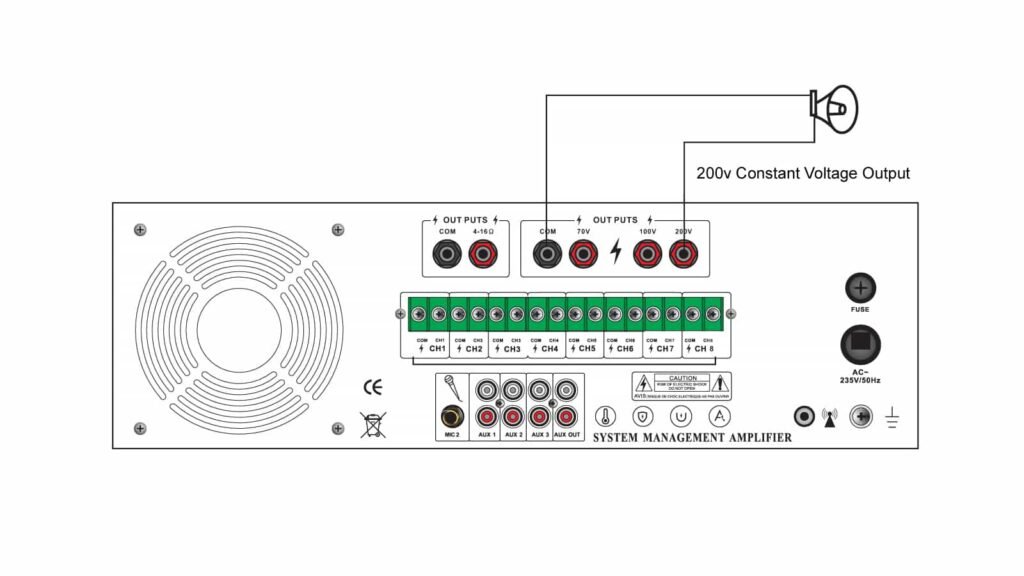
200 V Constant Voltage Output Terminal: This sub-output is used for connecting loudspeakers over long distance.It is not recommended for short distance.Always check to match the impedance of your loudspeakers first.
Conncetion 2
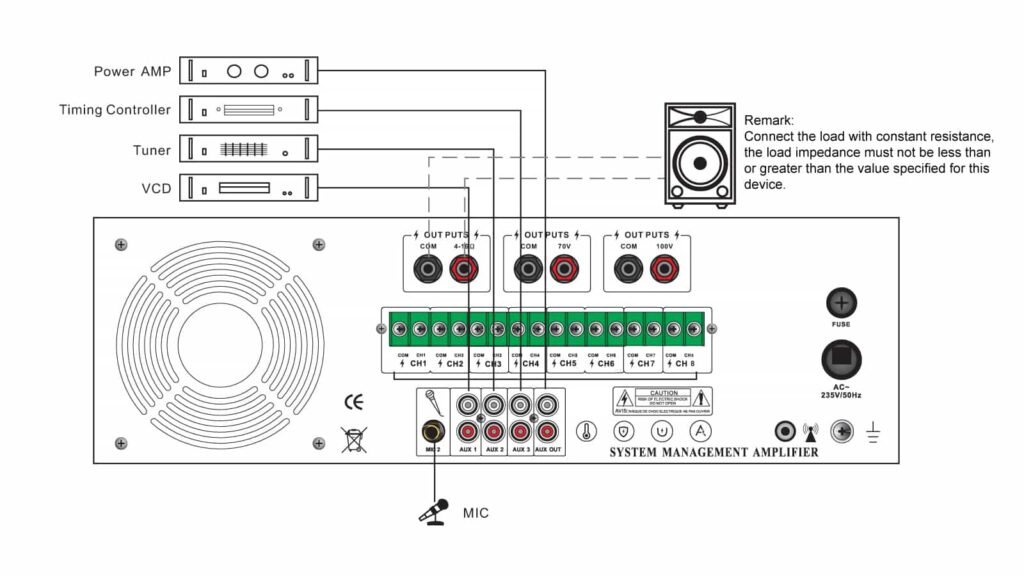
Connection 3
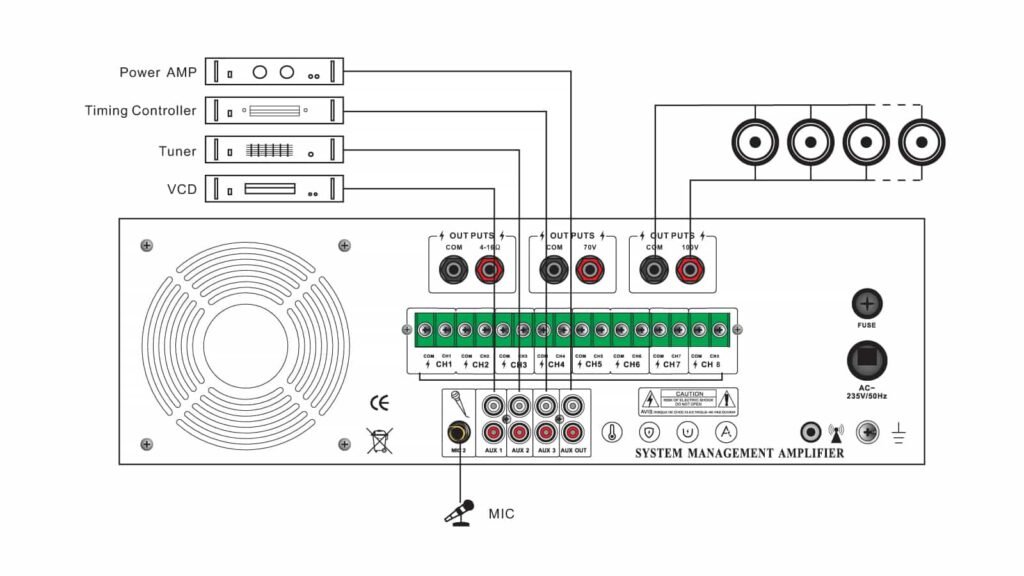
Connection 4
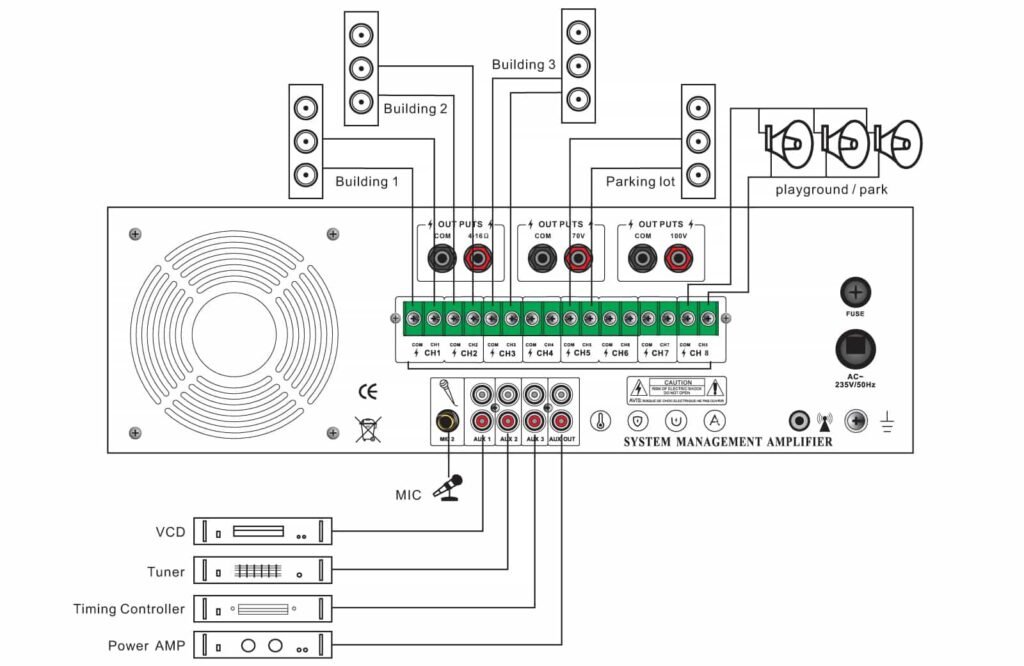
Understanding Power Output and Efficiency
RMS Power vs Peak Power
RMS Power and Peak Power are two important terms in the power amplifier field.RMS stands for Root Mean Square and is a mathematical term used to calculate the average power of a signal. Simply put, RMS power is the continuous power that an amplifier can output without damaging its components. It measures the steady state power that the amplifier can handle without any fluctuations.
On the other hand, peak power is the maximum power that an amplifier can output in a short time. It is the peak value of an electrical signal that the amplifier can handle. Peak power is usually measured in watts and is an important factor to consider when using a pro audio amplifier for live performances. This is because live performances often experience sudden spikes in volume, and a professional power amplifier with high peak power can handle these spikes without distortion or damage to its components.
Efficiency and Energy Consumption
The efficiency of a public address amplifier is the ability of the amplifier to convert electrical energy into sound energy. Simply put, it is a measure of an amplifier’s ability to amplify a sound signal without wasting energy. An amplifier with high efficiency uses less power to produce the same volume of sound compared to an amplifier with lower efficiency. The use of high-quality components and high-efficiency line designs (e.g., Class D) are key factors in improving efficiency.
Energy consumption is the amount of energy consumed to run the amplifier. Smaller room that require only lower-powered compact amplifier will have relatively low energy consumption. In addition, the type of loudspeaker and its sensitivity also affect the energy consumption of the amplifier. A more sensitive speaker requires less amplifier power to produce the same volume, thus saving energy. When selecting an amplifier, the load impedance of the loudspeaker must also be taken into account, as it can have a significant impact on efficiency and energy consumption.
Matching Amplifier Power to Speaker Requirements
Remember when I talked about impedance compatibility earlier? Well, now it’s time to bring it back. When choosing an amplifier, make sure its power output matches the requirements of your speakers. Whether it’s a public address amplifier or a professional stage amplifier, this is crucial for your audio system.
Factors to Consider When Choosing PA Power Amplifiers
Application and Venue Size
Different applications require different power levels and types. If you need to apply in schools, shopping malls, large warehouses, churches, or public safety (such as emergency firefighting), then you need a PA power amplifier. Depending on the size of the venue and the distance you can choose from 100W to 2000W in our PA amplifiers. You can also contact us to recommend the most suitable model for your use.
If it’s a need to enjoy music in your home or host a BBQ party, then our small amplifiers are more than enough to handle all your audio needs. It has a variety of built-in inputs and outputs, as well as the handy feature of DC12V.
When you need to use it in a large stage performance or wedding scene, our professional power amplifiers are your best choice.
Below are different watt and application power amplifiers
Numbers of Inputs and Outputs, Built-in Features
Do you have a vast collection of partitions that you want to connect simultaneously? Or perhaps you’re planning to daisy-chain multiple loudspeakers for some extra audio magic?
Below is a schematic of the buttons on the front and rear of our public address amplifier, which has enough input and output features to meet your audio needs. If you need additional customization features, please contact us.
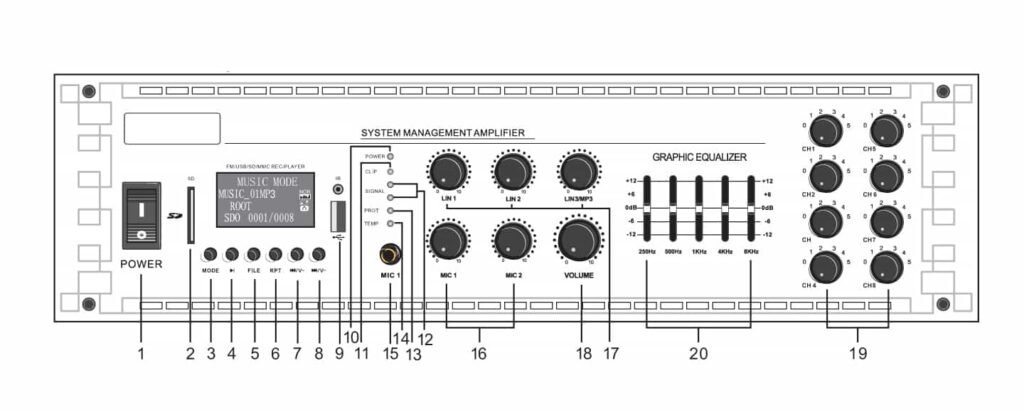
- Power On/Off
- SD Card Slot
- Mode: Used to select the operating mode of the device, the operating mode cycles in the order of “FM/AUX/MP3/Bluetooth”.
- Play and Pause: Short press this button to get the next stored radio station, and long press it to search and store stations automatically.
- File/Folder
- RPT/Repeat
- V- Short: press this button to go to the previous song, long press this button to lower the volume. In FM mode, press this key briefly to search for stations from high to low.
- V+ Short: press this button to go to the next song, long press this button to higher the volume. In FM mode, press this key briefly to search for stations from low to high.
- USB
- Power Indicator
- Clip
- Output Level Indicator
- Short Circuit Indicator/Overload Indicator
- High Temperature Indicator
- MIC 1 Input: This Microphone has the priority mute function
- Buttons for Adjusting the Microphone Input Level
- Buttons for Adjusting the Line and MP3 Input Level
- Volume Final Output Adjustment
- Individual Adjustment of Each Partition
- Five-band Graphic Equalizer
- Treble Adjustment
- Bass Adjustment
- ECHO Button
- Delay Button Button for adjusting the microphone reverb delay time.
- CHIME Button
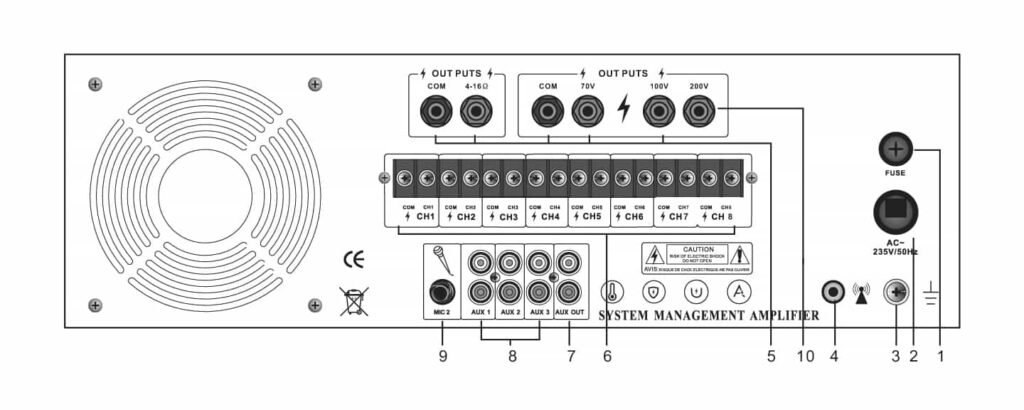
- Fuse
- Power Cord
- Ground Terminal
- Antenna
- Three Types of Output Terminal (4-16 /70 V/ 100 V)
- Output Terminal Eight zoned constant voltage outputs for connection to 100V loudspeakers. The outputs of loudspeakers 1 to 8 can be adjusted by the buttons corresponding to CH1 to 8 on the front panel.
- AUX/ Line Output
- RCA Connectors for 3 Stereo Line Inputs
- Microphone 2 and 3 Input
- 200V Constant Voltage Output Terminals: This sub output is used for connecting loudspeakers over long distances. It is not recommended for short distances, always check to match the impedance of your loudspeakers first.
Cost Savings of Bulk Purchasing
The public address power amplifier is a small but super-heavy product. For example, the model HZ-EQB-2000 has a net weight of 29.8 kg (66 lbs). If you buy one or two units and send them by air to North America or Europe, the air freight cost will be several hundred dollars. This shipping cost is enough to cover the cost of ocean freight for the purchase of 50 units, although ocean time is a few weeks slower than air freight.
Budgetary Considerations
Whether you shop online or buy from a store near you, prices for public address amplifiers vary widely. Without in-depth market research, you can hardly get a cost-effective product.
We have been specializing in power amplifier products for more than 10 years. Although we are still young for brand owners with decades of history, our 10+ years of production experience make our products have very stable quality. Moreover, we now open factory direct sales mode, and you will get high-quality and best-price amplifier products. Inquiry us anytime!
Conclusion and Final Thoughts
In conclusion, understanding the ins and outs of public address power amplifiers is crucial before making a purchase.
By considering key features, power output, efficiency, and other factors, you can ensure that the amplifiers meet your specific requirements and deliver high-quality audio.
Choose the appropriate amplifier for your actual needs, plus never get the impedance matching wrong.
With this knowledge, you can confidently make informed decisions and create an effective and reliable sound reinforcement system for your venue or space.
FAQ
What is the advantage of using public address power amplifiers?
Public address power amplifiers provide several advantages. They amplify audio signals to a level suitable for large venues and outdoor areas, ensuring clear and intelligible sound for the audience. These amplifiers also offer various input and output connectivity options, allowing you to connect multiple audio sources and speakers. Additionally, they often come equipped with built-in features like signal processing and equalization, enhancing the audio quality and overall performance of the sound system.
How do I determine the appropriate power output for my public address power amplifier?
Selecting the right power output for your public address power amplifier depends on several factors, including the size of the venue, the number of speakers, and the desired sound level. It is essential to consider the power requirements of your speakers and match them with the amplifier’s power output. Aim for an amplifier that offers sufficient power without overloading the speakers. Please inquire we can help you determine the ideal power output for your setup.
How should public address power amplifiers be maintained?
To ensure optimal performance and longevity of public address power amplifiers, proper maintenance is essential. Regularly inspect the amplifiers for any signs of damage, loose connections, or dust accumulation. Clean the amplifiers periodically using compressed air or a soft cloth to remove dust and debris. Ensure that the amplifiers are placed in well-ventilated areas to prevent overheating. Follow the user manual regarding servicing and maintenance schedules, and consider consulting professional technicians for routine check-ups or repairs if necessary.

